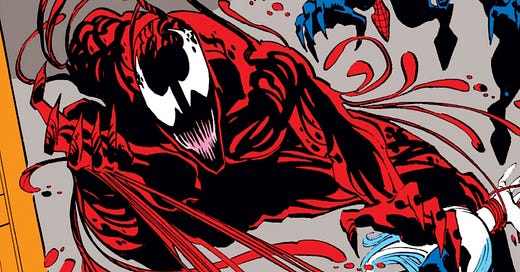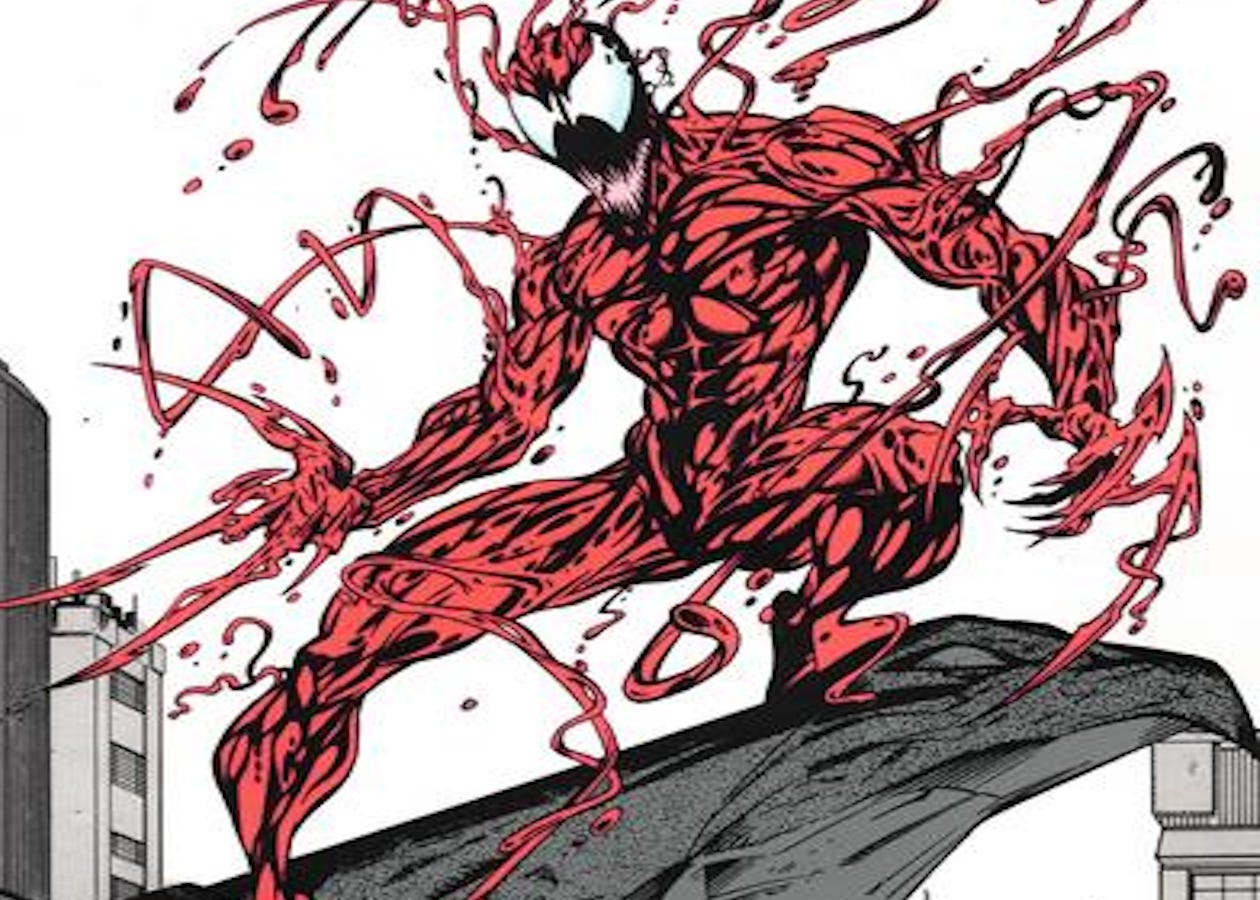Carnage: Marvel's Most Chaotic and Bloodthirsty Villain
Carnage is one of the most terrifying and chaotic villains in the Marvel Universe. First introduced in The Amazing Spider-Man #360 (1992), Carnage quickly became a fan-favorite villain, known for his unrestrained brutality and anarchic nature.
Created by writer David Michelinie and artists Mark Bagley and Erik Larsen, Carnage has cemented himself as a deadly adversary not only to Spider-Man but also to Venom, his symbiote parent. Cletus Kasady’s violent origins and the malevolent bond he shares with his symbiote make Carnage one of the most unique and chilling villains in comic book history.
First Appearance and Origin Story
After Cletus Kasady’s first appearance in Amazing Spider-Man #344 and a fleeting appearance of Carnage in The Amazing Spider-Man #360, the character made a full appearance in The Amazing Spider-Man #361 (1992), where he was revealed as the offspring of the Venom symbiote. The symbiote bonded with Cletus Kasady, a deranged serial killer who was sharing a prison cell with Eddie Brock, the host of the Venom symbiote. This happened after the Venom symbiote gave birth to a new symbiote that merged with Kasady, turning him into Carnage. Unlike Venom, who has his own code of honor, Carnage is completely driven by chaos and destruction. This is largely due to Kasady's nihilistic worldview, which is magnified by the symbiote's influence.
Cletus Kasady's backstory is as chilling as his actions as Carnage. Before becoming Carnage, Kasady was already a notorious criminal with a history of violence, having murdered his grandmother and tormented his mother. His partnership with the symbiote amplifies his psychotic tendencies, making him one of Spider-Man's most dangerous foes. The symbiote enhances Kasady's inherent madness, creating a perfect storm of malevolence that would terrorize the Marvel Universe for decades.
Key Relationships and Interactions
Carnage's relationship with Venom is complex and antagonistic. Venom, bonded with Eddie Brock, initially sought revenge against Spider-Man, but eventually developed a sense of morality and occasionally acted as an anti-hero. Carnage, on the other hand, lacks any moral compass. This fundamental difference puts the two symbiotes at odds. Their confrontations often reflect this dichotomy, with Venom occasionally teaming up with Spider-Man to stop Carnage’s murderous rampages.
One of the most iconic storylines that highlights this dynamic is Maximum Carnage (1993), a 14-part crossover spanning several Spider-Man titles. In this storyline, Carnage escapes from prison and assembles a group of like-minded villains to spread chaos across New York City. Venom, recognizing the threat Carnage poses, forms an uneasy alliance with Spider-Man and other heroes, including Black Cat and Captain America, to bring Carnage to justice. The storyline showcases Carnage's ability to incite mass hysteria and his sheer disregard for human life.
Carnage has also had significant interactions with other Marvel characters. In Carnage, U.S.A. (2012), he takes control of an entire small town, turning its residents into his symbiotic minions. This storyline highlights Carnage's potential to cause mass chaos and illustrates the threat he poses beyond his usual targets of Spider-Man and Venom. His ability to manipulate and dominate others with his symbiote powers makes him a formidable adversary capable of challenging even the strongest heroes in the Marvel Universe.
The Importance of Carnage in the Marvel Universe
Carnage represents the extreme end of the symbiotic spectrum in Marvel Comics. While Venom has been portrayed as a dark reflection of Spider-Man, exploring themes of vengeance, redemption, and the duality of man, Carnage embodies unrestrained chaos and pure evil. His existence forces characters like Spider-Man and Venom to confront their own darker impulses and the fine line between heroism and villainy.
Carnage's importance extends beyond his role as a villain. He serves as a narrative tool to explore darker themes within the Marvel Universe, such as the nature of evil, the impact of trauma, and the concept of justice. His presence often pushes other characters to their limits, both morally and physically. In Absolute Carnage (2019), written by Donny Cates and illustrated by Ryan Stegman, Carnage seeks to awaken an ancient symbiote god known as Knull. This storyline further develops Carnage as a central figure in the symbiote mythos and positions him as a catalyst for even larger cosmic threats.
Interesting Storylines Featuring Carnage
Carnage has been involved in several memorable storylines that have left a lasting impact on the Marvel Universe. One of the most notable is Carnage: Mind Bomb (1996), a one-shot story that presents a psychological horror exploring the depths of Carnage’s insanity. On a different note, Minimum Carnage (2012), takes a Honey I Shrunk the Kids approach and shrinks Carnage down to a microscopic size to wreak havoc in the Microverse.
In recent years, King in Black (2021) has further cemented Carnage's role in the Marvel Universe. This crossover event, also written by Donny Cates, sees Knull, the god of symbiotes, invading Earth with his symbiotic army, and Carnage plays a pivotal role as one of Knull's key allies. The storyline expands on the lore of the symbiotes and highlights Carnage's unwavering devotion to chaos and destruction, even in the face of cosmic threats.
Carnage: The Embodiment of Chaos
Carnage remains one of Marvel’s most compelling and terrifying villains due to his unrelenting nature and the sheer scale of his brutality. Unlike many other villains who seek power, wealth, or revenge, Carnage thrives on chaos and destruction for their own sake. This makes him an unpredictable and formidable foe, capable of pushing even the strongest heroes to their limits. As a character who embodies pure evil and chaos, Carnage reminding readers of the ever-present threat of unchecked power and the fragility of order in the face of utter madness.






